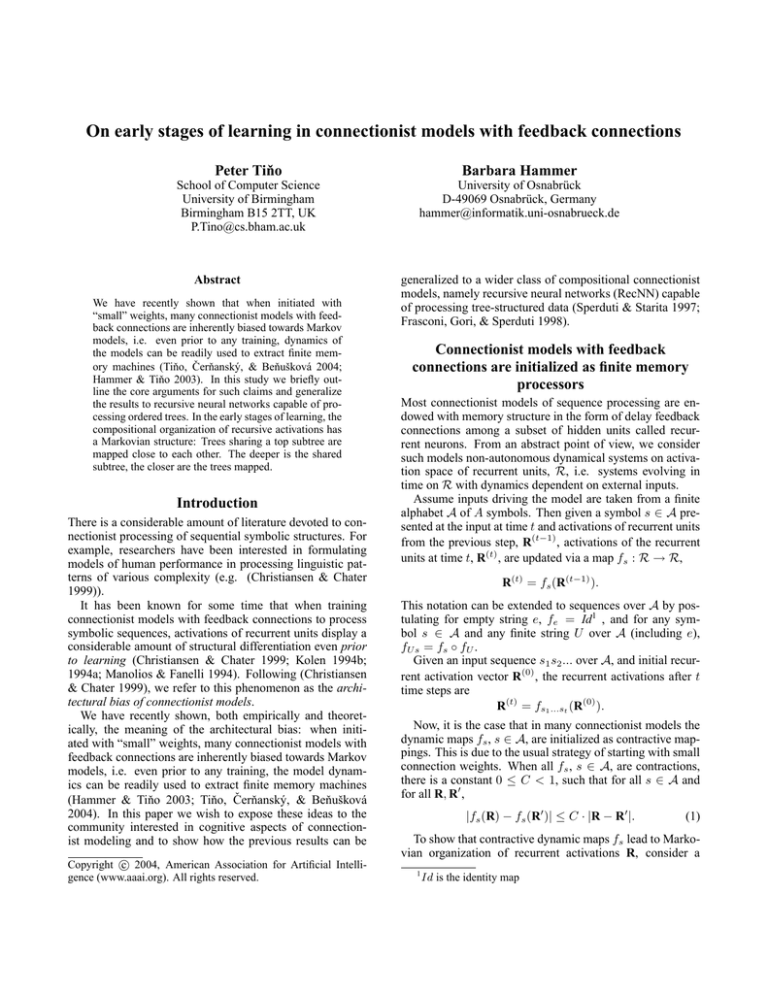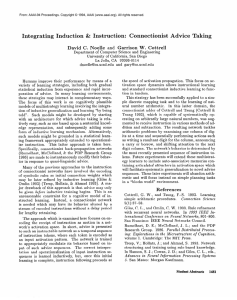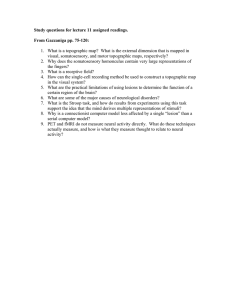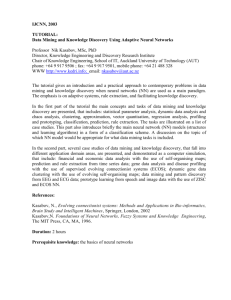
On early stages of learning in connectionist models with feedback connections
Peter Tiňo
Barbara Hammer
School of Computer Science
University of Birmingham
Birmingham B15 2TT, UK
P.Tino@cs.bham.ac.uk
University of Osnabrück
D-49069 Osnabrück, Germany
hammer@informatik.uni-osnabrueck.de
Abstract
We have recently shown that when initiated with
“small” weights, many connectionist models with feedback connections are inherently biased towards Markov
models, i.e. even prior to any training, dynamics of
the models can be readily used to extract finite memory machines (Tiňo, Čerňanský, & Beňušková 2004;
Hammer & Tiňo 2003). In this study we briefly outline the core arguments for such claims and generalize
the results to recursive neural networks capable of processing ordered trees. In the early stages of learning, the
compositional organization of recursive activations has
a Markovian structure: Trees sharing a top subtree are
mapped close to each other. The deeper is the shared
subtree, the closer are the trees mapped.
Introduction
There is a considerable amount of literature devoted to connectionist processing of sequential symbolic structures. For
example, researchers have been interested in formulating
models of human performance in processing linguistic patterns of various complexity (e.g. (Christiansen & Chater
1999)).
It has been known for some time that when training
connectionist models with feedback connections to process
symbolic sequences, activations of recurrent units display a
considerable amount of structural differentiation even prior
to learning (Christiansen & Chater 1999; Kolen 1994b;
1994a; Manolios & Fanelli 1994). Following (Christiansen
& Chater 1999), we refer to this phenomenon as the architectural bias of connectionist models.
We have recently shown, both empirically and theoretically, the meaning of the architectural bias: when initiated with “small” weights, many connectionist models with
feedback connections are inherently biased towards Markov
models, i.e. even prior to any training, the model dynamics can be readily used to extract finite memory machines
(Hammer & Tiňo 2003; Tiňo, Čerňanský, & Beňušková
2004). In this paper we wish to expose these ideas to the
community interested in cognitive aspects of connectionist modeling and to show how the previous results can be
c 2004, American Association for Artificial IntelliCopyright gence (www.aaai.org). All rights reserved.
generalized to a wider class of compositional connectionist
models, namely recursive neural networks (RecNN) capable
of processing tree-structured data (Sperduti & Starita 1997;
Frasconi, Gori, & Sperduti 1998).
Connectionist models with feedback
connections are initialized as finite memory
processors
Most connectionist models of sequence processing are endowed with memory structure in the form of delay feedback
connections among a subset of hidden units called recurrent neurons. From an abstract point of view, we consider
such models non-autonomous dynamical systems on activation space of recurrent units, R, i.e. systems evolving in
time on R with dynamics dependent on external inputs.
Assume inputs driving the model are taken from a finite
alphabet A of A symbols. Then given a symbol s ∈ A presented at the input at time t and activations of recurrent units
from the previous step, R(t−1) , activations of the recurrent
units at time t, R(t) , are updated via a map fs : R → R,
R(t) = fs (R(t−1) ).
This notation can be extended to sequences over A by postulating for empty string e, fe = Id1 , and for any symbol s ∈ A and any finite string U over A (including e),
fU s = f s ◦ f U .
Given an input sequence s1 s2 ... over A, and initial recurrent activation vector R(0) , the recurrent activations after t
time steps are
R(t) = fs1 ...st (R(0) ).
Now, it is the case that in many connectionist models the
dynamic maps fs , s ∈ A, are initialized as contractive mappings. This is due to the usual strategy of starting with small
connection weights. When all fs , s ∈ A, are contractions,
there is a constant 0 ≤ C < 1, such that for all s ∈ A and
for all R, R0 ,
|fs (R) − fs (R0 )| ≤ C · |R − R0 |.
(1)
To show that contractive dynamic maps fs lead to Markovian organization of recurrent activations R, consider a
1
Id is the identity map
string S = s1 s2 ...sr over A. For any two strings U, V over
A we have (Tiňo, Čerňanský, & Beňušková 2004)
|fU S (R) − fV S (R)|
≤
C r · |fU (R) − fV (R)| (2)
≤
C |S| · diam(R),
a
d
f
b c
d
e
R(n) = fs (R(n1 ) , R(n2 ) , ..., R(nk ) ).
The initial activation vectors in leaves are, as before, R(0) ∈
R. Once the whole tree has been recursively processed, the
activation vector in the root, R(root) ∈ R, codes the topology and node labelings of the tree. An illustration of recursive processing of a binary tree is presented in figure 1.
Consider trees G1 , G2 that share a common top subtree
G of depth d. In other words, up to certain depth d, the top
structures near the root in G1 and G2 are identical and equal
to G. The trees G1 , G2 differ only “bellow” G, i.e. at levels
2
in case of sequences there is only one leaf corresponding to the
first symbol in the sequence
a
f
f
f
f
e
f
(3)
where diam(R) is diameter of the activation space R of recurrent units. Hence, no matter what state R(0) the model
is initiated with, the neural codes fP (R(0) ), fQ (R(0) ) of
two sequences P, Q sharing a long common suffix S will
lie close to each other. Furthermore, the longer is the common suffix shared by P and Q, the closer lie fP (R(0) ) and
fQ (R(0) ).
Now, imagine that while observing an input stream S =
s1 s2 ... we have at our disposal only a finite memory length
L, i.e. all we can process are the most recent L input symbols. We can ask a question: How different would be recurrent activations R(t) (coding histories of inputs up to time
t) if instead of processing the whole sequence S we processed only the last L symbols of S, starting in the initial
state R(0) ? By the analysis above, the difference would be
at most C L · diam(R), which can be made arbitrarily small
by increasing the finite memory length L.
The types of models studied above processed sequential
data, but more involved generalized neural models for processing structured tree-like data have also appeared in the
literature (Sperduti & Starita 1997; Frasconi, Gori, & Sperduti 1998). The idea is simple. Sequences can be considered (k = 1)-ary trees, where each node has at most one
child. The processing flows in a bottom-up fashion, from
leaves2 to the root. Having computed the state information R(t−1) ∈ R about what nodes have already been processed so far, based on the label of the current node (symbol st at time t), we determine the updated representation
R(t) ∈ R of the history of symbols seen so far, including
st , as R(t) = fst (R(t−1) ). Initial activation in the leaf is
R(0) ∈ R. When processing (k > 1)-ary ordered trees, in
order to determine activation vector R(n) ∈ R for a node
n labeled by symbol s ∈ A, fed by k child nodes n1 ,
n2 , ..., nk , we need to take into account state informations
R(n1 ) ∈ R, R(n2 ) ∈ R, ..., R(nk ) ∈ R, that code processed
sub-trees rooted in the k child nodes. So the generalized
“state-transition” map fs : Rk → R has now the form
b
c
Figure 1: Example of a computation with a recursive function for a given binary tree.
G1
G
G2
G
a
a
a
c
a
b
b
c
a
b
a
b
a
c
c
a
c
b
c
b
b
U
c
V
Figure 2: Example of depth-6 trees G1 , G2 sharing a toplevel tree G of depth 4. G1 and G2 differ only in subgraphs
U, V feeding the leaves of G and the differences appear at
levels 5 and 6.
exceeding the depth of G. As an example, consider trees G1 ,
G2 in figure 2. The trees share the top portion G of depth
d = 4 and differ only in subgraphs U, V feeding the level4 leaves of G. The differences between G1 and G2 appear
only at levels 5 and 6.
Again, assume that all the maps fs , s ∈ A, are contractions, i.e. there is a constant 0 ≤ C < 1, such that
for each s ∈ A and for all R̄ = (R(n1 ) , R(n2 ) , ..., R(nk ) ),
R¯0 = (R0(n1 ) , R0(n2 ) , ..., R0(nk ) ), we have
(4)
|f (R̄) − f (R¯0 )| ≤ C · |R̄ − R¯0 | k .
s
s
R
R
Note that the Euclidean norms appearing in the above equation are defined on spaces of different dimensionality.
Denote by R(G1 ) and R(G2 ) the activation vectors in the
roots of graphs G! and G2 , respectively. By realizing that
for
|(R(n1 ) , R(n2 ) , ..., R(nk ) ) − (R0(n1 ) , R0(n2 ) , ..., R0(nk ) )|Rk
we have
k
X
|R̄ − R¯0 |Rk ≤
|R(nj ) − R0(nj ) |R
j=1
≤ k · max |R(nj ) − R0(nj ) |R
j
(5)
and using arguments analogous to those employed in the
case of sequential data, we arrive at
|R(G1 ) − R(G2 ) | ≤
k d−1 · C d · diam(R)
=
C · (k · C)d−1 · diam(R).
It follows that, as long as C < 1/k, no matter what subgraphs of G1 , G2 lie “bellow” the shared top tree G, the
representations R(G1 ) and R(G2 ) of G1 and G2 will lie close
to each other. Furthermore, the deeper is the common top
tree G shared by G1 and G2 , the closer lie the representations R(G1 ) , R(G2 ) . So when the maps fs , s ∈ A, are contractions with contraction coefficient C < k1 , the recursive
neural network will have the “Markovian” coding property
mapping trees sharing deep top subtrees close to each other.
Discussion and conclusion
Recently, we have extended the work of Kolen and others
(e.g. (Christiansen & Chater 1999; Kolen 1994b; 1994a;
Manolios & Fanelli 1994)) by pointing out that when initiated with “small” weights, connectionist models for processing sequential data are inherently biased towards Markov
models, i.e. even prior to any training, the internal dynamics of the models can be readily used to extract finite
memory machines (Tiňo, Čerňanský, & Beňušková 2004;
Hammer & Tiňo 2003). In other words, even without any
training, or in the early stages of learning, the recurrent activation clusters are perfectly reasonable and are biased towards finite-memory computations. We have also shown
that in such cases, a rigorous analysis of fractal encodings in
the model space can be performed (Tiňo & Hammer 2004).
Our analysis is general and applies to any connectionist model for processing sequential data that is initialized
with contractive dynamics. In fact, this initialization strategy is quite common and alternative initialization schemes
would need to be properly justified, as a-priori introduction of more complicated dynamical regimes (evolving e.g.
along periodic orbits) can complicate the training process
(Tiňo, Čerňanský, & Beňušková 2004). We plan to evaluate Markovian models extracted from connectionist models in the early stages of learning along the lines of (Tiňo,
Čerňanský, & Beňušková 2004) (e.g. using a neural selforganizing map as a quantizing extraction tool) in the context of connectionist studies of language learning/processing
in the cognitive science community.
In this paper we have further extended our results to a
more general class of connectionist models with feedback
connections, namely recursive neural networks (RecNN)
(Sperduti & Starita 1997; Frasconi, Gori, & Sperduti 1998)
capable of processing data represented as ordered trees. We
have shown that the notions of finite memory and Markovian
state organization generalize to processing trees by RecNN.
In the early stages of learning, the compositional organization of recursive activations has a Markovian structure:
Trees sharing a top subtree are mapped close to each other.
The deeper is the shared subtree, the closer are the trees
mapped to each other.
References
Christiansen, M., and Chater, N. 1999. Toward a connectionist model of recursion in human linguistic performance.
Cognitive Science 23:417–437.
Frasconi, P.; Gori, M.; and Sperduti, A. 1998. A general
framework of adaptive processing of data structures. IEEE
Transactions on Neural Networks 9(5):768–786.
Hammer, B., and Tiňo, P. 2003. Neural networks with
small weights implement finite memory machines. Neural
Computation 15(8):1897–1926.
Kolen, J. 1994a. The origin of clusters in recurrent neural network state space. In Proceedings from the Sixteenth
Annual Conference of the Cognitive Science Society, 508–
513. Hillsdale, NJ: Lawrence Erlbaum Associates.
Kolen, J. 1994b. Recurrent networks: state machines or
iterated function systems? In Mozer, M.; Smolensky, P.;
Touretzky, D.; Elman, J.; and Weigend, A., eds., Proceedings of the 1993 Connectionist Models Summer School.
Hillsdale, NJ: Erlbaum Associates. 203–210.
Manolios, P., and Fanelli, R. 1994. First order recurrent
neural networks and deterministic finite state automata.
Neural Computation 6(6):1155–1173.
Sperduti, A., and Starita, A. 1997. Supervised neural networks for the classification of structures. IEEE Transactions on Neural Networks 8(3):714–735.
Tiňo, P., and Hammer, B. 2004. Architectural bias in recurrent neural networks: Fractal analysis. Neural Computation 15(8):1931–1957.
Tiňo, P.; Čerňanský, M.; and Beňušková, L. 2004. Markovian architectural bias of recurrent neural networks. IEEE
Transactions on Neural Networks 15(1):6–15.





